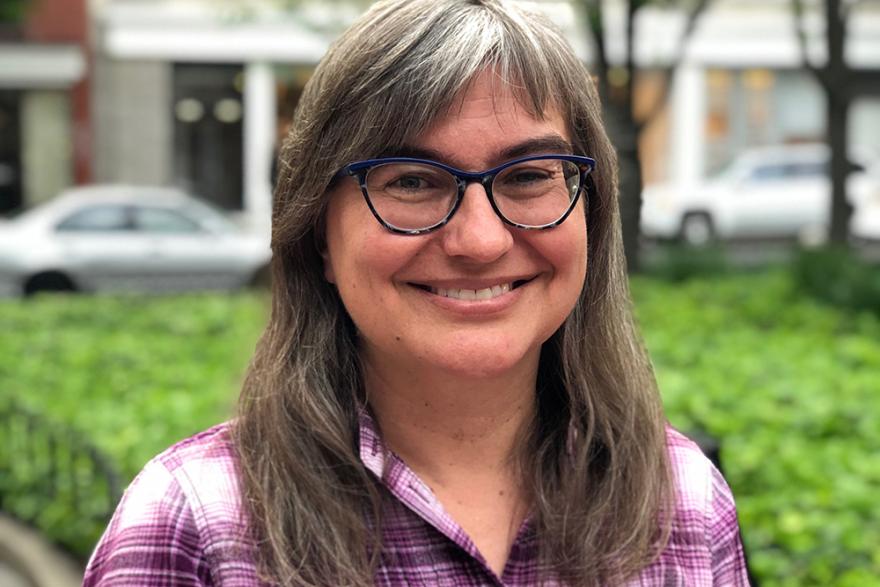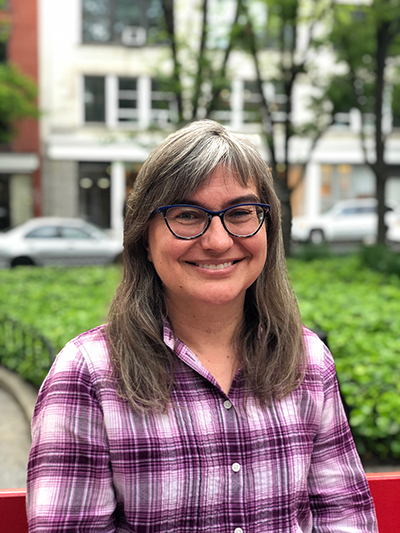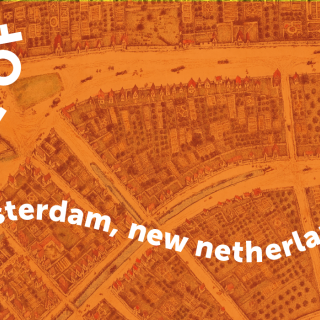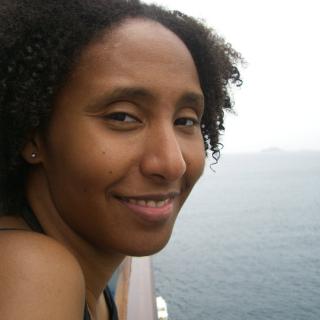Professor Susanah Shaw Romney

I grew up many miles away from the site of Dutch colonization – in California, just about as far from old New Amsterdam as you can get in the US. But I became fascinated by the cultural interactions that were part of colonization while I was in college at UC Santa Cruz, and I decided to give grad school a try. Then, at Cornell, when I was taking a class on women in American history with the historian Mary Beth Norton, she asked the class to each do a research paper. I went to the library and found the translated court records from New Amsterdam, and thought I would take a look and see if I could find any women in the records. I was blown away! There were so many women, white, Black, and Native, suing powerful men, running businesses, and even getting into swearing matches with each other. It was like a soap opera – their lives were totally addictive. I realized that if I was going to understand their world, I would have to learn Dutch and spend time in the archives in the Netherlands. Years later, I know the women much better, and I’ve even ferreted out some of their deepest secrets, but I’m still hooked.
1) What is colonialism? What was its role in New Netherland?
That’s a surprisingly tricky question! Colonialism can mean a lot of different things. The historian Nancy Shoemaker came up with a list of twelve different kinds of colonialism, from “extractive colonialism,” where outsiders seek to exploit an area’s natural resources, to “missionary colonialism,” where outsiders set up systems of religious conversion. In New Netherland’s case, we can speak of “trade colonialism,” where outsiders set up outposts and made jurisdictional claims in order to trade for local products, and “settler colonialism,” where outsiders came and took land from Native people in order to farm it themselves.
In the early years, trade colonialism was most important in New Netherland, as ships came annually from the Netherlands to exchange cloth, axes, and other European goods for beaver skins hunted and processed by Native people like the Mahicans and Mohawks and wampum beads made by Lenape-Munsees, Unkechaugs, and others that could be used to buy skins. That trade system really got started after Hudson’s voyage in 1609. In the years after that, you see the establishment of occasional winter campsites where the Dutch would stay year-round and even a fort at present-day Albany. The Dutch made claims to the Hudson, Connecticut, and Delaware River areas, and began labeling the region “New Netherland” on maps they made, but they knew perfectly well that Indigenous people were really the ones in charge; the Dutch land claims were largely an attempt to keep competing European traders from getting involved in the beaver skin trade in the area.
By 1624, though, the Dutch also began sending permanent, year-round settlers, supported by enslaved people. They began building towns and farms on the land, and more migrants began coming to take advantage of opportunities in the growing settlement, importing more African enslaved men and women as time went on. People did not stop trading for beaver skins, but gradually the growing need for farmland would lead to very different relationships with Native Americans, particularly Lenape-Munsee groups living on rich farmland on the shores of the Hudson River. That kind of expansive colonialism, which almost always leads to conflict with Indigenous residents, is what scholars call “settler colonialism,” and by the time the English took over the colony in 1664, that was the predominant form of colonialism being practiced in the region.
2) What were some social and economic opportunities that were open for the colonists of New Netherland?
Trade with Native Americans created a growing economy in the colony. Colonists could buy beaver skins and sell them to the Dutch West India Company (WIC), and after 1638 they could export them to Amsterdam for sale on their own. Beaver pelts were even used as currency in the colony, worth 8 guilders, which was equal to a sailor’s monthly wages from the WIC. Getting even a few skins could really make a difference to a poor person. Colonists tried to produce things that they knew their Lenape-Munsee neighbors in Manhattan, and their Mohawk neighbors at Beverwijck (present-day Albany), wanted, like shoes or even pretzels and cookies.
They also farmed for their own consumption and to sell crops to the WIC, since the company needed to feed the soldiers and sailors they employed. People of wealthier means also got involved in the smuggling and export business, shipping tobacco grown in the English colonies in the Chesapeake to Amsterdam for sale. There were also a lot of travelers who came through the colony, since ships going from the Caribbean back to Europe sometimes stopped there. Those ships needed food supplies for their journeys, which they bought in the colony. New immigrants also passed through Manhattan. Because of New Amsterdam’s role as a port and place of trade with many people coming and going, operating inns and taverns was a common business for established New Amsterdammers. People also worked for the WIC itself, as ministers or teachers or merchants or soldiers.
3) Were there any equal social and economic opportunities for men and women in New Amsterdam?
The only women employed by the WIC were midwives, so jobs for the Company were for the most part restricted to men. A few men worked as “factors,” or merchant-representatives, for family companies in the Netherlands that were engaged in the fur trade, and that, too, was something closed to women. So was working as a sailor or ship-captain. But farming, being an artisan like a shoemaker or baker, and inn-keeping were all cooperative careers, in which husbands and wives worked together to run the business. Women could become sole operators as widows, especially since women very often outlived men in the seventeenth century. Many families farmed but also ran a small side business like a tavern, and in these cases, you can tell that often it was the wife who ran the tavern while the husband was busy running the farm. So, even though officially the business was in the husband’s name, it was really a woman-run affair. Families sometimes needed to export their beaver skins to sell in Amsterdam, and it could make sense to have the wife cross the ocean with the pelts while the husband stayed in Manhattan running the shoemaking business, for example. That meant that women played an important part in the international beaver skin trade.
A woman who wanted to stay unmarried and have a career in the colony might have a hard time. Immigrant girls and women who came from the Netherlands to cook, clean, and care for children in colonists’ houses were very poorly paid, and there wasn’t a lot of other wage work for women in the colony. Nonetheless, the fact that there were more men than women in New Netherland made it possible for most white women to get married if they wanted to – the opposite was true in Holland, where many men left home to take work at sea, and poor women sometimes stayed single (and working as poorly-paid maids) lifelong. Through marriage, though, white women participated in all aspects of the economy alongside men during their married lives and as widows. This situation does not meet our definition of “equality” by a long shot, because women would have found it very difficult to earn wages equal to men’s or live independently if they wanted to. Still, white women probably had more opportunities for social mobility in the colony than they would have if they had stayed at home in the Netherlands.
4) What was the racial and ethnic makeup of the residents of New Amsterdam?
New Amsterdam was very diverse, especially if you compare it to some early New England settlements where a large number of Puritans came from only five counties in England! Many the very first year-round settlers on Manhattan were Walloons: French speaking religious refugees from what is today Belgium. The sailors and soldiers who worked for the WIC had often come to Amsterdam looking for work from places like Germany, Scotland, France, and England, and a fair number of them stayed on as settlers in New Netherland after their term of service was up. A few people came to the colony from some of the other far-flung places where the Dutch were active as traders around the world – one pair of brothers came from Salé in Morocco. And then there were the people forced to come from Africa as slaves of the WIC.
Many of the first group of enslaved people to arrive, who came in the late 1620s, were from the Kingdom of Kongo in what is today Angola. This was a region where the Portuguese had been active as traders already for a century by the time New Netherland was founded, and a particular Kongolese style of Catholicism was spreading there. So, some of these enslaved Africans would have spoken Portuguese and been Christians, while others would have come from elsewhere on the coast of West Central Africa and merely been trafficked through Kongo, meaning that even among this group there was diversity. Other enslaved people mentioned in court or church records came from other parts of Africa and other sites of Portuguese colonization, like the islands of São Thome and Cape Verde and even Brazil.
Plus, New Amsterdam was surrounded by vibrant and diverse Indigenous communities, and even though Native people lived separately and did not become residents of New Amsterdam per se, they came to town frequently to sell food and firewood (in addition to beaver skins and wampum beads) and to buy things they wanted from the Dutch. So, if you had walked down Breestraat (Broadway) in New Amsterdam in, say, 1654, you might have seen a very diverse set of people as you made your way to Fort Amsterdam.
5) How did class and race intersect and impact the lives of women (Black, European, and Indigenous?) in New Amsterdam?
Women’s lives were deeply affected by their race and class. New Netherland was not a colony where intermarriage was very common (unlike the Dutch colony on Java, where interracial unions were the norm). That means that the economic opportunities that came with marriage were not equally available to women of all races. We don’t have any examples of an African woman who married a Dutch artisan and traveled back and forth across the ocean for the beaver skin trade, for example. White men still sought relationships with African women, enslaved and free, but they rarely seem to have offered them the protections that came with marriage. That said, we do see examples of enslaved and formerly enslaved African women who married enslaved African men. This is not something you would see in neighboring English colonies, because enslaved status made access to legal marriage impossible there. The ability to form families that were formally recognized by white neighbors and colony officials really mattered and made it possible for Black women and men to be economic partners as farmers, and to do things like adoptions that helped others in their community. Yet class intersected with race to make life in the colony very difficult for African women, even once they managed to escape slavery. Freed African farm families tended to get smaller grants of lands than white couples. Many of them had to make annual payments of crops to the WIC or former owners. Therefore, the Black population in the colony seems to have been stuck in poverty that was difficult for them to escape – you don’t see any examples of free Black merchants or tavernkeepers who became well-off, which you actually can see in eighteenth-century Jamaica, for instance.
Class definitely shaped the experiences of white women. Soldiers and sailors who worked for the WIC were overwhelmingly very poor, and their wives sometimes struggled with poverty in New Netherland. White couples of this class often carried heavy debts. Wives of these poor WIC workers who lived in the Netherlands occasionally were able to get free passage on a Company ship to America, but others remained at home and experienced some very desperate economic realities as poor women on their own. In the colony, widows of these men – who did not own farms or businesses, but rather depended on wages – fell into very difficult circumstances and sometimes resorted to poor relief from the church. I suspect they would have felt, especially if they had children, that they simply had to remarry right away, and that might not have always been appealing for someone grieving the loss of a beloved partner. Most of the economic opportunities available to women in the colony were reserved for those married to men of at least moderate means.
The situation for Indigenous women was very different. Lenape-Munsee and Mohawk women alike enjoyed very high status within their own communities. Most of those communities continued to thrive economically throughout the Dutch period, since only some groups faced a devastating loss of land before 1664. Except for a few instances, most Indigenous women lived in their own communities, rather than in Dutch settlements. They participated in trade and took part in the regional economy with New Netherland, but their realities were determined by their own villages, clans, and nations, not colonial ones. Yet in interactions with the colony, they often did find their authority disregarded. Dutch men tended to ignore Indigenous women who came as diplomats, choosing to negotiate with men, instead. And women from communities, like Esopus, that faced land theft, violence, and warfare from settler groups found their livelihoods as farmers taken away from them.
6) What were the shifting legal standards for enslaved women and children in New Amsterdam and New Netherland (how does it change over the time period)?
New Netherland did not develop an explicit “slave code,” or body of laws that governed what slavery looked like. Early neighboring English colonies like Massachusetts also lacked slave codes, so this wasn’t entirely unusual. As a result, the boundaries of slavery, and the protections of freedom, weren’t totally clear in the colony. For example, in many colonies in the New World, enslaved people could not marry legally, or needed an owner’s permission to do so. But in New Netherland, we see the names of African couples in the marriage registry from the beginning of the record book in 1639. We also see that the children of African couples received baptism in the Dutch Reformed Church. Some of these African men petitioned for their freedom (and that of their wives) from the WIC in the 1640s, and received it, along with grants of land. The document that stated their new status mentioned that they should be regarded as having the same rights as other free people.
That story can make the picture sound quite rosy for New Netherland, though, and that would be a misimpression. Most enslaved Africans did not get their freedom, only a select group. And the freedom grants also departed from tradition in just about every other colony in the Americas by stating that even though the enslaved petitioners and their wives would receive freedom, their children – even unborn children conceived after the freedom grant – would remain enslaved. Almost everywhere else, the condition of the child followed the mother, so if a woman was free when she gave birth, her children would be free. Thus, the lack of a slave code made it possible for African people to be denied the full protections of freedom when they managed to achieve it.
Over time, barriers to baptism and formal marriage rose, and by the mid-1650s, no more Black children received baptism during the Dutch era. There was no legal change that we can see – no new laws prevented the inclusion of Africans and their children in the church community. But even in the absence of new or changing laws, the way New Netherlanders practiced slavery seems to have become more rigid.
7) What kind of interactions did white and Black New Amsterdammers have with Indigenous people?
I guess I would say that interactions between New Amsterdammers and Indigenous people were wide, but not deep. In other words, Black and white settlers saw Indigenous people a lot, and met with them and traded with them. They even socialized and drank together, now and then. They got to know each other well enough to learn each other’s languages. But only rarely did people move on to the next step – only occasionally did they live in one another’s towns or build families together. It did happen now and then, but these kinds of deep interactions, with a lot of cultural sharing, were not an everyday occurrence, as far as I can see from the records.
So, what kind of interactions did they have? Nearby Native neighbors to New Amsterdam would cut wood and deliver firewood to colonists’ homes, which shows they knew people there well enough to have an idea where different people lived in town. And people’s need for firewood was very great, since they used it in the kitchen year-round as well as to heat their homes in wintertime. Firewood production was an activity that we see a lot of enslaved and freed people doing, as well, so it really was a big part of economic activity and daily life. We see Long Island’s Native residents, like the Marechkawicks and Massapequa, coming to town by canoe and pulling up onshore to sell food in the marketplace at the water’s edge. People did a lot of bargaining and bartering at the market, meaning that marketing required talking to one another. Native people were a big enough part of the marketplace that some of New Amsterdam’s settler housewives even learned to speak Munsee. Native people were buyers in the market, as well as sellers – they bought so much bread that colonists complained in the 1650s that prices were going up and bakers were saving the best flour for Native customers.
Colonists also bought food like fish and venison from Native men who came to town, and sometimes went by canoe to Lenape-Munsee villages to buy corn grown by Native women. One of the things colonists sold to their Native neighbors was alcohol, which was illegal, but they did it anyway. This could be a social exchange, too, in which a visitor came inside the colonist’s house and sat around smoking and drinking, while also doing some trading. Other times, colonists went by boat secretly to Lenape-Munsee towns to sell larger amounts of alcohol. Native people from further away also came through New Amsterdam for diplomacy, so Mohawks visited the town, too, even though they did not live nearby. Native visitors were common enough that the colony’s governing council wanted housing built just for them.
I don’t want to paint too rosy a picture. I’m describing the kind of interactions you saw during times of peace. But the lower Hudson area, including Manhattan, saw plenty of warfare. Colonists reported that during the fighting known as Kieft’s War, in the early 1640s, settler forces committed atrocities against women as part of a campaign of terror. We know that some Native women who came to settler towns to trade were the victims of crime, like robbery and beatings. African men were employed in military actions against Native people, too. Even though all the trade shows that people could get along day to day, I think that the shallowness of the interactions made things prone to break down into ugly violence when times were tough.
8) What drew you to the story of Reytory Angola? Why did she become an important subject of study for your personal research? Why is she significant to the larger study of New Amsterdam?
Ever since I first read the petition for a document stating the freedom of Reytory’s adopted son, I was really moved by her powerful presence. The petition talks about her love for Anthony. It talks about how hard she worked for him. That kind of statement of emotion is unusual in the sort of documents that survive, which are often court records or contracts. And that kind of statement of emotion is exceedingly rare in the kinds of documents that survive about Africans. Since white people wrote all the documents we have surviving from New Netherland, and since white people regarded Africans, most often, as property, there is next to nothing that survives in Africans’ own voices about their family lives or feelings. But Reytory achieved something different; she got her husband to go before a white notary and pay him to make a record about how much she loved young Anthony. That made me want to know more about her. I wasn’t sure at first that I would be able to trace her story over time, and there are still gaps that I wasn’t able to fill in. But I like to think that she was such a strong person that she made an impression even on a white population that was trying hard to ignore the humanity of people like her.
I think stories like hers are significant for history-writing because every time that we can learn about the life of an enslaved person, we are countering the work that was done, long ago, to erase the personhood of all Africans in America. It matters that we can know something about an enslaved woman, and not have the image that we have of the colony be dominated solely by the white men who held the pens and wrote the documents at the time. Reconstructing lives like hers is a small part of the larger work we all must do as a society to reckon with the enduring legacy of the colonial era.





